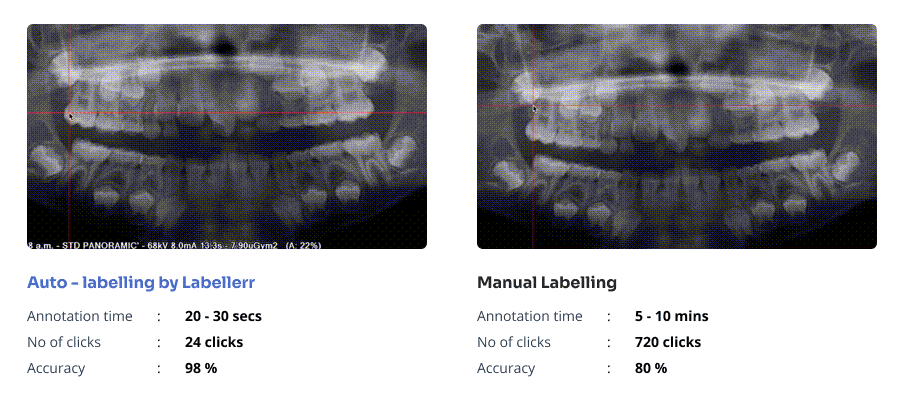Automate Dental Image Annotation With Labellerr Using SAM

Table of Contents
- Introduction
- Challenge
- Solution: Labellerr for Annotating Dental Imaging
- Conclusion
- Frequently Asked Questions
Introduction
Dental prediction and detection with the help of computer vision technology represent groundbreaking advancements in oral healthcare.
Using algorithms and machine learning models, these systems can analyze dental images to predict potential issues and detect abnormalities with remarkable accuracy.
However, the success of such systems heavily relies on the availability of annotated datasets.
Labellerr, an annotation platform, plays an important role in annotating dental images, enabling the creation of labeled datasets essential for training robust prediction and detection models in dentistry.
Challenge
The field of dental prediction and detection presents a complex array of challenges rooted in dental imaging and pathology.
Complexity of dental structures and anomalies: Dental images depict complex structures such as teeth, gums, and surrounding tissues. It is necessary to accurately capture even the slightest irregularities while annotating these images.
Dental anomalies range from cavities and fractures to periodontal diseases. Such diseases frequently present as minor differences in images, demanding expert annotation for accurate identification.
Annotators can use an active learning approach to help the model find uncertain regions in images and prioritize them for annotation by dental specialists. This directs annotation efforts toward the most important locations for improving model accuracy.
Data imbalance: Certain dental problems are underrepresented in existing datasets. If this data imbalance is not corrected during training, it may result in biased AI models.
Annotators may use Data Augmentation Techniques: Use data augmentation techniques such as image flipping, rotation, and noise addition to artificially expand and diversify the dataset for underrepresented dental disorders.
Or annotators can use synthetic data generation to examine the feasibility of creating synthetic dental images with various diseases using simulation techniques. This can enhance real-world data while also addressing specific data imbalance issues.
Privacy regulations: Strict privacy requirements require careful management of dental images to protect patient confidentiality and data security. This increases the difficulty of the annotating process.
Annotators may use Federated Learning, in which models are trained on individual devices or local servers with dental pictures. This eliminates the need for centralized data storage and reduces privacy issues.
Overcoming these challenges requires advanced annotation methodologies and tools to ensure accuracy, consistency, and compliance while generating high-quality labeled datasets essential for training accurate prediction and detection models in dentistry.
Solution: Labellerr For Annotating Dental Imaging

To address these challenges, companies and researchers employ annotation platforms like Labellerr to streamline the annotation process.
By harnessing Labellerr's capabilities, they can annotate data with increased speed and accuracy, thereby doubling their release velocity for developing AI-powered image analysis software.
Read the full documentation for using SAM in an annotation workflow with Labellerr.
Below we discuss multiple factors by which Labellerr helps teams to overcome challenges.
Cost Savings
Labellerr offers significant cost savings for dental prediction and detection tasks by optimizing the annotation process and reducing manual labor costs.
Its advanced automation features streamline the annotation workflow, minimizing the need for extensive human intervention.
Automating repetitive tasks and leveraging efficient annotation algorithms allows dental professionals to annotate large volumes of images efficiently and cost-effectively, ultimately saving time and resources.
Intuitive Interface
Labellerr provides an intuitive user interface designed to simplify the annotation process for dental professionals.
Its user-friendly design and navigation tools allows annotators to label dental abnormalities with ease, reducing the learning curve and enhancing productivity.
Labellerr's intuitive interface allows annotators to focus on annotation tasks without being hindered by the complexity of dental imaging data.
Robust Segmentation Features
Labellerr incorporates robust segmentation features that enable accurate and precise annotation of complex datasets.
Its advanced algorithms can effectively outline objects and structures within images or videos, even in large and diverse datasets.
Labellerr's segmentation capabilities can ensure the accuracy and reliability of labeled data, enhancing the performance of machine learning models trained on these datasets.
Custom Workflows
Labellerr supports customizable workflows for specific requirements of dental prediction and detection tasks.
Dental professionals can define custom annotation protocols, designate abnormality categories, and customize labeling criteria to suit their unique needs.
This flexibility ensures that annotations are consistent, standardized, and aligned with the objectives of the project, ultimately leading to more reliable and accurate labeled datasets for training dental prediction and detection models.
Active Learning Based Labeling
Labellerr employs active learning techniques to optimize the dental prediction and detection process.
By intelligently selecting the most informative samples for annotation, Labellerr maximizes the efficiency of data labeling, reducing manual effort while improving the performance of trained models.
This active learning-based approach enables dental professionals to prioritize labeling efforts on data points that are most beneficial for model training, ultimately leading to more accurate and effective dental prediction and detection models.
Automated Import and Export of Data
Labellerr streamlines the process of importing and exporting data for land cover classification tasks with its automated functionalities.
Organizations can seamlessly upload large volumes of data to the platform and export annotated data for compatibility with various analysis tools and frameworks.
By automating data import and export processes, Labellerr ensures seamless integration with existing workflows, maximizing workflow efficiency and productivity.
Collaborative Annotation Pipeline
Labellerr facilitates collaboration among dental professionals with its collaborative annotation pipeline.
Multiple users can work simultaneously on annotating dental images for prediction and detection tasks, allowing for distributed workflows and real-time collaboration.
This collaborative approach enhances productivity and ensures consistency and accuracy in the labeled dataset, ultimately improving the performance of dental prediction and detection models.
Automated QA (Quality Assurance)
Labellerr integrates automated quality assurance mechanisms to ensure the accuracy and reliability of annotated dental data.
Advanced algorithms analyze annotations in real time, flagging inconsistencies or errors for review by dental professionals.
This automated QA process maintains the quality of the labeled dataset, reducing the risk of errors and ensuring the high performance of trained models in dental prediction and detection tasks.
Conclusion
In conclusion, Labellerr allows easy dental prediction and detection through its comprehensive annotation solutions.
By addressing the challenges associated with annotating dental images, Labellerr empowers dental professionals to create accurate and reliable datasets essential for training robust prediction and detection models.
Labellerr allows the development of precise and effective dental prediction and detection models, ultimately contributing to improved diagnosis, treatment planning, and patient care in dentistry.
Frequently Asked Questions
Q1) What is dental prediction and detection, and why is it important in dentistry?
Dental prediction and detection involve using computer vision technology to analyze dental images and predict potential issues or detect abnormalities such as cavities, fractures, and periodontal diseases.
It is crucial for early diagnosis, treatment planning, and preventive care in dentistry.
Q2) How does Labellerr assist in annotating dental images for prediction and detection tasks?
Labellerr provides advanced annotation tools and features specifically designed for annotating dental images.
Its intuitive interface, robust segmentation capabilities, and integration with object detection models streamline the annotation process, enabling dental professionals to annotate images efficiently and accurately for analysis.

Simplify Your Data Annotation Workflow With Proven Strategies
Download the Free Guide

